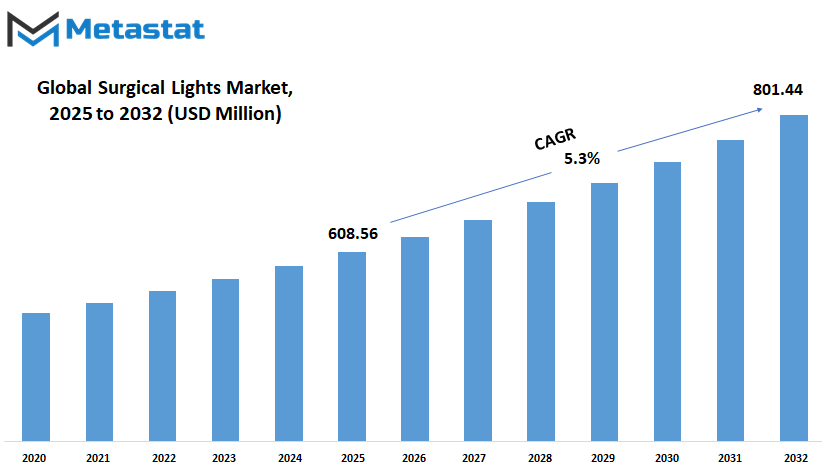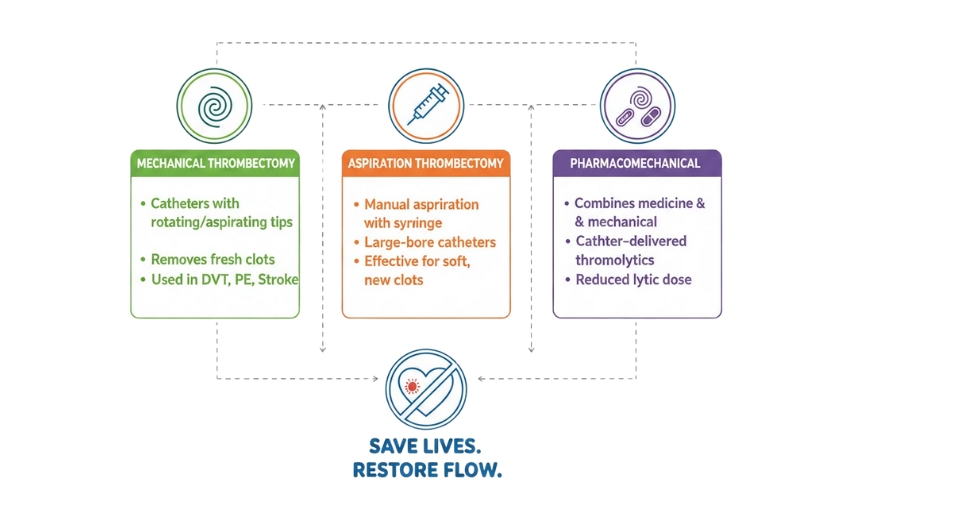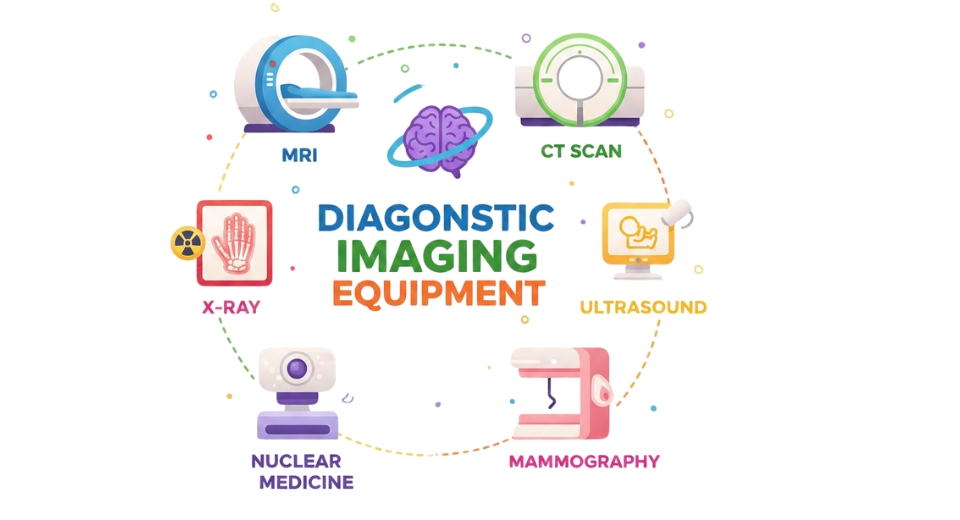MARKET OVERVIEW
The global surgical lights market is one of the most important components in the healthcare sector contributing significantly to highly accurate and safe performance in surgical procedures. Surgery light is mounted in most operating rooms to enable surgeons to improve their observation of their environment, interpret more clearly, and conduct operations successfully without pain. This market involves a wide range of technologies and configurations designed to address the stringent requirements of contemporary health centers and, therefore, stands very significant in the development of surgical procedures globally. Surgical lights have come a long way following technological advancements as well as the sophistication in medical procedures.
They are not just limited to elementary lighting but currently incorporate sophisticated functionalities such as variable intensity, color rendition, shadow elimination, and energy saving. These aspects are designed with care to meet the demanding conditions of the surgical setup, where compromise in illumination can risk diminishing patient results. Indeed, hospitals, ambulatory surgery facilities, and specialty clinics form the major market for such products, which are employed to assist procedures across a broad range of medical specialties such as orthopedic surgery, neurosurgery, cardiothoracic surgery, and general surgery. The global surgical lights market is dominated by an extensive line of products that meet various clinical needs. Companies are interested in developing options that enhance operative efficiency and comfort for healthcare professionals from the basic ceiling-mounted lights to transportable units.
Among the most revolutionary trends in the market is the introduction of LED technology. It is driven by several factors: energy efficiency, low heat radiation, and increased operational life. With increasingly sophisticated surgical methods, there is an increasing interest in lighting equipment that may be able to fit compatibly with other sophisticated operating room technology, including image systems and robotic surgical systems.
The future will also be characterized by advancements in design and function that keep pace with the present demands of healthcare professionals. This will also include personalization whereby surgical teams will be able to use lighting solutions tailored to individual procedural demands. In addition, with the emergence of digital technologies in the guise of IoT-based systems and artificial intelligence, communication between surgical lights and the remainder of the operating room will be altered forever.
All such innovations will not only develop but enhance accuracy and reliability in surgery, thus providing a guarantee for ongoing investment in research and development. Regional trends of healthcare, influencing regional differences throughout the region, are also indicated by the global surgical lights market. This region is currently set to be a source of higher growth for emerging economies with betterment in the healthcare system and modernization of such systems. On the side of their need for affordable but quality solutions, producers would be forced to innovate as well as customize their products in order to satisfy expectations that do not merely encompass accessibility but also performance.
Finally, more than ever, the global surgical lights market is an anchor cornerstone of surgical care, in the development of health providers' capabilities worldwide. Emphasizing accuracy, innovation, and flexibility, the market will keep on shifting and provide solutions to dynamic challenges in modern medicine. Technological developments will quicken, and next-generation surgical lighting will be improved in terms of more quality and more safety as it consolidates its crucial role in global healthcare systems.
Global surgical lights market is estimated to reach $773.33 Million by 2032; growing at a CAGR of 5.3% from 2025 to 2032.

MARKET DETERMINANTS
The global surgical lights market is on the increase globally, especially because of health-related needs. This increase is largely fueling the demand for sophisticated surgical illumination systems. However, as this is the case, LED lighting has advanced to make such systems even more energy efficient and brighter, further expanding their use in healthcare facilities. Technological advancements in LED lighting create more defined and accurate lighting of the surgical environment as a prime area for enhancing patient outcomes. There are some issues that could impede the growth of the market, though.
First among these is the exorbitant initial investment of placing sophisticated surgical lighting systems. These are expensive to implement, and maintenance costs are also quite high. Hospitals and health centers need to weigh these expenses against the benefits of employing such technology. Further, there are medical concerns related to prolonged exposure to intense lighting, which could affect medical personnel in the long term. These concerns could prevent some medical institutions from adopting these advanced lighting technologies. In spite of these problems, the future of the surgical lighting market remains rosy. What is available is an ongoing evolving option for energy-saving, adjustable lighting systems that perform more effectively.
Improvements in smart lighting technology, including IoT-enabled lighting, can make surgical lighting systems more flexible and precise. The intelligent systems will provide more control over the conditions and will more likely equate to improved surgical accuracy and patient safety. As the health sector expands, the demand for high-tech grows. This will thus mean that new lighting systems have a vital part to play in surgery in the near term.
In the coming years, attention is going to be placed on developing cost-efficient intelligent and adaptable light solutions for operations. These innovations present the possibility of further enhancing the accuracy of surgery, and this adds up to a highly appealing prospect for the market. This can extend to not only healthcare professionals but also patients. The expanding market will render these technologies more affordable and value-added, bringing them into the contemporary health arena.
REPORT SCOPE
By Type
The global surgical lights market are a component of every surgical procedure. They must give off a bright, concentrated beam of light so that the surgeon has the clearest possible view of the site of surgery. The operating room requires special lighting, and surgical lights come in various forms with advantages. The most frequent types of surgical lights are LED surgical lights, halogen surgical lights, and hybrid surgical lights.
The other significant benefit is that they use power and last for extremely long periods. They emit a brilliant intense light but minimal heat, therefore significant for comfortable long-duration surgeries. It is extremely simple to switch on/off the LED lights based on various regions of the surgery area to give just sufficient light, therefore precise work for the surgeon.
This type of lighting also has a relatively lower power consumption compared to the others and thus proves economical in the long run. Halogen lights for surgery, on the other hand, are preferred because they are warm and bright. They emit a lot of brightness that is necessary for surgeries involving intricate work. The only drawback of halogen lights is that they emit a lot of heat, which is very inconvenient to the operating team as well as the patient. Nevertheless, most clinics and hospitals do prefer the use of halogen lights because of their efficiency and affordability.
Hybrid surgical lamps borrow the best of LED and halogen light. The lights allow for varying levels of brightness and can be designed to provide the advantages of both. They are giving the bright, crisp lighting that is offered by a halogen bulb, but simultaneously providing energy efficiency and low heat emission like LED lights. Hybrid lights tend to be considered versatile since they can be adapted to meet the different demands of different operations. There is a type of surgical lighting with its unique advantages, chosen based on a procedure's surgical needs as well as on an operating room design and budget. Now LED's becoming popular to provide significantly longer lifetime and highly diminished energy consumption, nevertheless the brightness supplied by a halogen's light makes it unique to spend its time.
In conclusion, a hybrid type offers an acceptable balanced middle solution towards gaining from them. Being aware of these differences will allow a medical practitioner to make the appropriate choice of lighting for maximized surgical performance.
By Mobility
Surgical lights are classified according to type of mobility into different forms that vary from ceiling-mounted, wall-mounted, stand-based mounting, and portable-based mounting. All the different surgical lights mentioned above are intended to cater to a specific demand of medical establishments depending on available space in the operating room or procedural setup and required mobility therein. The most popular ceiling-mounted surgical lights utilized in operation rooms are the fixed models which are installed to the ceiling. They are made to be highly adjustable so that surgeons can position them exactly as desired. The benefits of utilizing ceiling-mounted lights are that they do not take up valuable floor space and can be readily shifted along the ceiling to yield maximum lighting during operations.
Wall-mount surgical lights are mounted on the wall and usually are applied for a smaller or more confined place. Although these lights are adjustable, their adjustment is far less than ceiling mounts. Wall-mount lights are ideal for procedures needing less space, particularly for use in clinic exam rooms where ceiling space might not be feasible or available.
Surgical lights that are mounted on mobile stands are convenient and easy to move around. These lights are placed on a wheeled stand, allowing them to be shifted within a room. The light will be helpful in situations where procedures can be performed at various locations because it will enable medical practitioners to carry the light where they need it most.
The fourth is surgical lights with a mobile base. They are even more mobile since they are transferred from one location to another. They are commonly applied in emergency or operating rooms where agility is necessary. Such lights are so versatile and fit all locations, such as hospitals, clinics, and field hospitals, due to portability.
Each surgical mobility type is used for a specific purpose, so there is proper lighting for different medical requirements. Depending on whether flexibility with setup is required, the surgical light has to be different, but all offer what is required to illuminate what is occurring in significant operations.
By Application
The global surgical lights market has been divided into different application-based categories, and each category plays a highly significant role in a different type of surgery. The most significant ones that have been enumerated are General Surgery, Orthopedic Surgery, Neurosurgery, ENT (Ear, Nose, and Throat) Surgery, Dental Surgery, Ophthalmic Surgery, Plastic & Reconstructive Surgery, and Gynecology & Urology Surgery. All types of surgery are pertinent to specific health problems and require, respectively, specialized treatment that would give improved patient outcomes.
General surgery, in general, is the specialty of surgeries relating to the abdominal organs and the soft tissue. General surgery has wide surgeries and is one of the most commonly performed types of surgery related with appendicitis, hernias, and all the diseases related to the gallbladder. Orthopedic surgery encompasses all aspects of the musculoskeletal system, i.e., bones, joints, muscles, tendons, and ligaments. It is required to cure whatever has occurred to lead to deformity or disease in this complex, like fractures, arthritis, spinal disorders, etc. Neurosurgery is one of the procedures in which operations concerning the brain, the spine, and the nervous system take place.
In the aforementioned field, surgeons put their maximum efforts into treating conditions, including brain tumors and spinal cord injuries, and other neurological disorders in a way that utilizes complex techniques that would never cause any irreparable damage to the nervous system. ENT Surgery ENT encompasses the ear, the nose, and the throat. In this specialty, there exists a surgeon who deals with an enormous majority of health disorders. Among the health disorders dealt with are hearing loss, sinus complications, throat infection, and complications of the voice box, among others.
Dental Surgery Another most crucial category is dental surgery that is specifically concerned with the oral health problems and tooth extraction, implants, or jaw surgery. These conditions are most necessary for oral well-being and would also prevent one from severe dental diseases. Ophthalmic Surgery deals with completely eye health, and the procedures are in relation to such things as the cataract development, glaucoma, or issues of the retina. In this area, surgeons also encounter such problems as enhancing the vision usually through the employment of novel technologies.
Regarding the rehabilitation or reconstruction of elements of a human body that are susceptible to being injured, suffering diseases, or from genetic disorders. The Cosmetic surgery is another subcategory of this division on enhancement of the external appearance of a human. The third one is Gynecology & Urology Surgery. It addresses surgical requirements of the female reproductive apparatus and the urinary system. In surgery in Gynecology, conditions are fibroids, cancers, whereas in the case of Urology, surgery addresses issues related to kidneys, bladder, and even other regions in the urinary system. All these surgical specialties thus play very distinctive roles since they encounter the different health requirements while supporting healthy and well-lived lives.
By End-User Industry
The global surgical lights market has been divided based on end-user industries present in the global market. Such industries include hospitals, ambulatory surgical centers, outpatient surgical centers, and clinics. The highest number of end-user industries for surgical lights is represented by hospitals. This is because hospitals carry out numerous types of surgery which need proper and uniform lighting. Those devices for lighting hospitals aid in procedures with complete observation so that the medical experts can perform those procedures effectively and less likely with mistake. Sophisticated technology in lights supporting surgeries plays a significant role in identifying safe patients in the provided healthcare services alongside complicated cases.
The significant features of that market include ambulatory surgical centers. These facilities offer surgical services to patients who do not require an overnight stay and use surgical lights for most of their procedures. ASCs will most likely entertain less invasive procedures but would nonetheless need high-quality lights to be able to conduct an efficient and safe procedure. Increased ASCs worldwide translate to increased demand for surgical lights because of increased service extension by these facilities, along with greater use of technology. Outpatient surgical centers are similar to ASCs but deal with same-day operations where the patients leave the facility after a few hours.
The need for these centers also requires surgical lights to ensure precision for that operation. Outpatient treatments, as being less costly, much more accessible to all in such a period where in-patient treatments require heavy overheads and are comparatively more difficult to perform, have increased the need for surgical light solutions. Since the patients are increasingly favorable for outpatient treatments, these facilities are also spending money on all the latest lighting technologies and equipment that can enhance patient care quality.
Surgical service-providing clinics are also major users of surgical lights. Clinics perform a wide range of procedures ranging from minor surgery to the more complicated forms of treatment. The demand for surgical lights in clinics has been rising due to the growth of medical practices and widening of services by them. These lights assist in maintaining the level of visibility required for precise procedures and in ensuring that the patients are safe during the procedures. With each of these end-user industries continuing to grow, demand for sophisticated surgical lights will increase accordingly.
Meanwhile, surgical lighting technology would likewise develop to meet the growing demand of hospitals, ASCs, outpatient centers, and clinics to improve the quality of medical care delivery and operatory efficiency in surgery.
|
Report Coverage |
Details |
|
Forecast Period |
2025-2032 |
|
Market Size in 2025 |
$5608.56 million |
|
Market Size by 2032 |
$801.44 Million |
|
Growth Rate from 2025 to 2032 |
5.3% |
|
Base Year |
2024 |
|
Regions Covered |
North America, Europe, Asia-Pacific Green, South America, Middle East & Africa |
REGIONAL SEGEMENTATION
The global surgical lights market is geographically segmented across North America, Europe, Asia-Pacific, South America, and the Middle East & Africa. It further bifurcates in greater detail in North America- - U.S., Canada, and Mexico. Europe breaks up to comprise the UK, Germany, France, Italy, and rest of Europe. Asia-Pacific breaks up into India, China, Japan, South Korea, and the rest of Asia-Pacific. The South America segment includes Brazil, Argentina, and the balance of South America. Lastly, the Middle East & Africa segment is divided between the GCC nations, Egypt, South Africa, and the rest of Middle East & Africa. The dynamics and needs for surgical lights in each of these segments will be varied based on the health infrastructure, economic situation, and technology advancement. For instance, Europe and North America tend to have highly developed health infrastructures with a high demand for sophisticated medical equipment.
Conversely, rising markets in South America and Asia-Pacific are likely to have a strong growth trend since their health infrastructures are in the process of development and improvement. The Middle East & Africa market is differentiated in terms of potential, with some regions like the GCC nations investing heavily in healthcare while others are hampered by political instability and economic conditions. Geographic segmentation of the market allows room for manufacturers and the stakeholders involved to concentrate their strategy on particular regions, knowing local requirements and growth possibilities. With this, a company can fulfill local needs and position itself in the global surgical lights market.

MARKET LEADERS
The global surgical lights market is geographically segmented across North America, Europe, Asia-Pacific, South America, and the Middle East & Africa. It further bifurcates in greater detail in North America - U.S., Canada, and Mexico. Europe breaks up to comprise the UK, Germany, France, Italy, and rest of Europe. Asia-Pacific breaks up into India, China, Japan, South Korea, and the rest of Asia-Pacific. The South America segment includes Brazil, Argentina, and the balance of South America. Lastly, the Middle East & Africa segment is divided between the GCC nations, Egypt, South Africa, and the rest of Middle East & Africa. The dynamics and needs for surgical lights in each of these segments will be varied based on the health infrastructure, economic situation, and technology advancement. For instance, Europe and North America tend to have highly developed health infrastructures with a high demand for sophisticated medical equipment.
Conversely, rising markets in South America and Asia-Pacific are likely to have a strong growth trend since their health infrastructures are in the process of development and improvement. The Middle East & Africa market is differentiated in terms of potential, with some regions like the GCC nations investing heavily in healthcare while others are hampered by political instability and economic conditions. Geographic segmentation of the market allows room for manufacturers and the stakeholders involved to concentrate their strategy on particular regions, knowing local requirements and growth possibilities. With this, a company can fulfill local needs and position itself in the global surgical lights market.
Surgical Lights Market Key Segments:
By Type
- LED Surgical Lights
- Halogen Surgical Lights
- Hybrid Surgical Lights
By Mobility Type
- Ceiling Mounted Surgical Lights
- Wall Mounted Surgical Lights
- Surgical Light with Mobile Stands
- Surgical Lights with Portable Base
By Application
- General Surgery
- Orthopedic Surgery
- Neurosurgery
- ENT (Ear, Nose, and Throat) Surgery
- Dental Surgery
- Ophthalmic Surgery
- Plastic & Reconstructive Surgery
- Gynecology & Urology Surgery
By End-User Industry
- Hospitals
- Ambulatory Surgical Centers (ASCs)
- Outpatient Surgical Centers
- Clinics
Key Global Surgical Lights Industry Players
- Philips Healthcare
- Getinge Group
- Stryker Corporation
- Steris Corporation
- Dr. Mach GmbH
- GE Healthcare
- Maquet (A part of Getinge Group)
- Burton Medical
- A-dec Inc.
- Skytron LLC
- Integra LifeSciences Corporation
- YA HAI International Inc.
- Examion GmbH
- Mindray Medical International Limited
- Nova Medical
WHAT REPORT PROVIDES
- Full in-depth analysis of the parent Industry
- Important changes in market and its dynamics
- Segmentation details of the market
- Former, on-going, and projected market analysis in terms of volume and value
- Assessment of niche industry developments
- Market share analysis
- Key strategies of major players
- Emerging segments and regional growth potential








 US: +1 3023308252
US: +1 3023308252






